The Effect of Short Chain Carboxylic Acids as Additives on the Crystallization of Methylammonium Lead Triiodide (MAPI)
Abstract
:1. Introduction
2. Results
2.1. Crystal Habit
2.2. Crystallographic Study
3. Discussion
3.1. Crystal O: MAPI Crystallized without Additives
3.2. Crystal A: MAPI Crystallized with Acetic Acid as an Additive
3.3. Crystal B: MAPI Crystallized with Formic Acid as an Additive
3.4. Crystal Bseed: MAPI Nucleated with Acetic Acid as an Additive and Grown with Formic Acid as an Additive
3.5. Crystal C: MAPI Crystallized with Trifluoroacetic Acid as an Additive
3.6. X-ray Powder Diffraction
3.7. Structural Comparison among the MAPI Crystals
3.8. Raman Characterization
4. Materials and Methods
4.1. Synthesis of Hybrid Perovskite Crystals
4.2. Acids’ Effect on MAPI Crystallization
4.3. Single Crystal X-ray Diffraction
4.4. X-ray Powder Diffraction
4.5. Raman Spectroscopy
5. Conclusions
Author Contributions
Funding
Data Availability Statement
Acknowledgments
Conflicts of Interest
References
- Xing, G.; Mathews, N.; Sun, S.; Lim, S.S.; Lam, Y.M.; Grätzel, M.; Mhaisalkar, S.; Sum, T.C. Long-range balanced electron-and hole-transport lengths in organic-inorganic CH3NH3PbI3. Science 2013, 342, 44–347. [Google Scholar] [CrossRef] [PubMed]
- Lee, M.M.; Teuscher, J.; Miyasaka, T.; Murakami, T.N.; Snaith, H.J. Efficient Hybrid Solar Cells Based on Meso-Superstructured Organometal Halide Perovskites. Science 2012, 338, 643–647. [Google Scholar] [CrossRef] [Green Version]
- Chen, C.; Li, C.; Li, F.; Wu, F.; Tan, F.; Zhai, Y.; Zhang, W. Efficient perovskite solar cells based on low-temperature solution-processed (CH3NH3)PbI3 perovskite/CuInS2 planar heterojunctions. Nanoscale Res. Lett. 2014, 9, 457. [Google Scholar] [CrossRef] [PubMed] [Green Version]
- Fan, Z.; Xiao, H.; Wang, Y.; Zhao, Z.; Lin, Z.; Cheng, H.C.; Lee, S.J.; Wang, G.; Feng, Z.; Goddard, W.A., III.; et al. Layer-by-layer degradation of methylammonium lead tri-iodide perovskite microplates. Joule 2017, 1, 548–562. [Google Scholar] [CrossRef] [Green Version]
- Saparov, B.; Mitzi, D.B. Organic–inorganic perovskites: Structural versatility for functional materials design. Chem. Rev. 2016, 116, 4558–4596. [Google Scholar] [CrossRef] [PubMed]
- Ma̧czka, M.; Gagor, A.; Zarȩba, J.K.; Stefanska, D.; Drozd, M.; Balciunas, S.; Šimėnas, M.; Banys, J.; Sieradzki, A. Three-dimensional perovskite methylhydrazinium lead chloride with two polar phases and unusual second-harmonic generation bistability above room temperature. Chem. Mater. 2020, 32, 4072–4082. [Google Scholar] [CrossRef]
- Zhao, Y.; Tan, H.; Yuan, H.; Yang, Z.; Fan, J.Z.; Kim, J.; Voznyy, O.; Gong, X.; Quan, L.N.; Tan, C.S. Perovskite seeding growth of formamidinium-lead-iodide-based perovskites for efficient and stable solar cells. Nat. Commun. 2018, 9, 1607. [Google Scholar] [CrossRef] [Green Version]
- Sheldrick, G.M. A short history of SHELX; SHELXL97. Acta Cryst. A 2008, 64, 112. [Google Scholar] [CrossRef] [Green Version]
- Li, N.; Feng, A.; Guo, X.; Wu, J.; Xie, S.; Lin, Q.; Jiang, X.; Liu, Y.; Chen, Z.; Tao, X. Engineering the Hole Extraction Interface Enables Single-Crystal MAPbI3 Perovskite Solar Cells with Efficiency Exceeding 22% and Superior Indoor Response. Adv. Energy Mater. 2022, 12, 2103241. [Google Scholar] [CrossRef]
- Li, J.; Gu, Y.; Han, Z.; Liu, J.; Zou, Y.; Xu, X. Further Advancement of Perovskite Single Crystals. J. Phys. Chem. Lett. 2022, 13, 274–290. [Google Scholar] [CrossRef]
- Gupta, R.; Korukonda, T.B.; Gupta, S.K.; Dhamaniya, B.P.; Chhillar, P.; Datt, R.; Vashishtha, P.; Gupta, G.; Gupta, V.; Srivastava, R. Room temperature synthesis of perovskite (MAPbI3) single crystal by anti-solvent assisted inverse temperature crystallization method. J. Cryst. Growth 2020, 537, 125598. [Google Scholar] [CrossRef]
- Fateev, S.A.; Petrov, A.A.; Ordinartsev, A.A.; Grishko, A.Y.; Goodilin, E.A.; Tarasov, A.B. Universal Strategy of 3D and 2D Hybrid Perovskites Single Crystal Growth via In Situ Solvent Conversion. Chem. Mater. 2020, 32, 9805–9812. [Google Scholar] [CrossRef]
- Saidaminov, M.I.; Abdelhady, A.L.; Murali, B.; Alarousu, E.; Burlakov, V.M.; Peng, W.; Dursun, I.; Wang, L.; He, Y.; Maculan, G. High-quality bulk hybrid perovskite single crystals within minutes by inverse temperature crystallization. Nat. Commun. 2015, 6, 7586. [Google Scholar] [CrossRef] [PubMed] [Green Version]
- Kadro, J.M.; Nonomura, K.; Gachet, D.; Grätzel, M.; Hagfeldt, A. Facile route to freestanding CH3NH3PbI3 crystals using inverse solubility. Sci. Rep. 2015, 5, 11654. [Google Scholar] [CrossRef] [PubMed] [Green Version]
- Zhang, T.; Yang, M.; Benson, E.E.; Li, Z.; van de Lagemaat, J.; Luther, J.M.; Yan, Y.; Zhu, K.; Zhao, Y. A facile solvothermal growth of single crystal mixed halide perovskite CH3NH3Pb(Br1−xClx)3. Chem. Commun. 2015, 51, 7820–7823. [Google Scholar] [CrossRef] [PubMed]
- Chen, L.-C.; Chen, C.-C.; Chen, J.-C.; Wu, C.-G. Annealing effects on high-performance CH3NH3PbI3 perovskite solar cells prepared by solution-process. Sol. Energy 2015, 122, 1047–1051. [Google Scholar] [CrossRef]
- Nayak, P.K.; Moore, D.T.; Wenger, B.; Nayak, S.; Haghighirad, A.A.; Fineberg, A.; Noel, N.K.; Reid, O.G.; Rumbles, G.; Kukura, P. Mechanism for rapid growth of organic–inorganic halide perovskite crystals. Nat. Commun. 2016, 7, 13303. [Google Scholar] [CrossRef] [Green Version]
- Zhu, H.; Duan, C.; Qin, M.; Liu, Z.; Li, J.; Yuan, L.; Wen, Q.; Lu, X.; Shi, L.; Xie, J. Trifluoromethylphenylacetic Acid as In Situ Accelerant of Ostwald Ripening for Stable and Efficient Perovskite Solar Cells. Sol. RRL 2021, 5, 2100040. [Google Scholar] [CrossRef]
- Meng, L.; Wei, Q.; Yang, Z.; Yang, D.; Feng, J.; Ren, X.; Liu, Y.; Liu, S.F. Improved perovskite solar cell efficiency by tuning the colloidal size and free ion concentration in precursor solution using formic acid additive. J. Energy Chem. 2020, 41, 43–51. [Google Scholar] [CrossRef] [Green Version]
- Baikie, T.; Barrow, N.S.; Fang, Y.; Keenan, P.J.; Slater, P.R.; Piltz, R.O.; Gutmann, M.; Mhaisalkar, S.G.; White, T.J. A combined single crystal neutron/X-ray diffraction and solid-state nuclear magnetic resonance study of the hybrid perovskites CH3NH3PbX3 (X = I, Br and Cl). J. Mater. Chem. A 2015, 3, 9298–9307. [Google Scholar] [CrossRef]
- Jaffe, A.; Lin, Y.; Beavers, C.M.; Voss, J.; Mao, W.L.; Karunadasa, H.I. High-pressure single-crystal structures of 3D lead-halide hybrid perovskites and pressure effects on their electronic and optical properties. ACS Central Sci. 2016, 2, 201–209. [Google Scholar] [CrossRef] [PubMed]
- López, C.A.; Abia, C.; Rodrigues, J.E.; Serrano-Sánchez, F.; Nemes, N.M.; Martínez, J.L.; Fernandez-Díaz, M.T.; Biškup, N.; Alvarez-Galván, C.; Carrascoso, F. Enhanced stability in CH3NH3PbI3 hybrid perovskite from mechano-chemical synthesis: Structural, microstructural and optoelectronic characterization. Sci Rep. 2020, 10, 11228. [Google Scholar] [CrossRef] [PubMed]
- Lee, J.-W.; Seo, S.; Nandi, P.; Jung, H.S.; Park, N.-G.; Shin, H. Dynamic structural property of organic-inorganic metal halide perovskite. Iscience 2021, 24, 101959. [Google Scholar] [CrossRef] [PubMed]
- Weller, M.T.; Weber, O.J.; Henry, P.F.; Di Pumpo, A.M.; Hansen, T.C. Complete structure and cation orientation in the perovskite photovoltaic methylammonium lead iodide between 100 and 352 K. Chem. Commun. 2015, 51, 4180–4183. [Google Scholar] [CrossRef] [Green Version]
- Zhong, M.; Zeng, W.; Tang, H.; Wang, L.X.; Liu, F.S.; Tang, B.; Liu, Q.J. Band structures, effective masses and exciton binding energies of perovskite polymorphs of CH3NH3PbI3. Solar Energy 2019, 190, 617–621. [Google Scholar] [CrossRef]
- Sheldrick, G.M. SHELXT–Integrated space-group and crystal-structure determination. Acta Crystallogr. A Found. Adv. 2015, 71, 3–8. [Google Scholar] [CrossRef] [Green Version]
- Sheldrick, G.M. Crystal structure refinement with SHELXL. Acta Crystallogr. C Struct. Chem. 2015, 71, 3–8. [Google Scholar] [CrossRef] [Green Version]
- Dolomanov, O.V.; Bourhis, L.J.; Gildea, R.J.; Howard, J.A.; Puschmann, H. OLEX2: A complete structure solution, refinement and analysis program. J. Appl. Crystallogr. 2009, 42, 339–341. [Google Scholar] [CrossRef]
- Wilson, A.J.C.; Geist, V. International Tables for Crystallography. Volume C: Mathematical, Physical and Chemical Tables. Kluwer Academic Publishers, Dordrecht/Boston/London 1992 (published for the International Union of Crystallography), 883 Seiten, ISBN 0-792-3-16-38X. Cryst. Res. Technol. 1993, 28, 110. [Google Scholar] [CrossRef]
- Poglitsch, A.; Weber, D. Dynamic disorder in methylammoniumtrihalogenoplumbates (II) observed by millimeter-wave spectroscopy. J. Chem. Phys. 1987, 87, 6373–6378. [Google Scholar] [CrossRef]
- Kawamura, Y.; Mashiyama, H.; Hasebe, K. Structural study on cubic-tetragonal transition of CH3NH3PbI3. J. Phys. Soc. Jpn. 2002, 71, 1694–1697. [Google Scholar] [CrossRef] [Green Version]
- Yamada, Y.; Yamada, T.; Phuong, L.Q.; Maruyama, N.; Nishimura, H.; Wakamiya, A.; Murata, Y.; Kanemitsu, Y. Dynamic optical properties of CH3NH3PbI3 single crystals as revealed by one-and two-photon excited photoluminescence measurements. J. Am. Chem. Soc. 2015, 137, 10456–10459. [Google Scholar] [CrossRef]
- Stoumpos, C.C.; Malliakas, C.D.; Kanatzidis, M.G. Semiconducting tin and lead iodide perovskites with organic cations: Phase transitions, high mobilities, and near-infrared photoluminescent properties. Inorg. Chem. 2013, 52, 9019–9038. [Google Scholar] [CrossRef] [PubMed]
- Dang, Y.; Liu, Y.; Sun, Y.; Yuan, D.; Liu, X.; Lu, W.; Liu, G.; Xia, H.; Tao, X. Bulk crystal growth of hybrid perovskite material CH3NH3PbI3. Crystengcomm 2015, 17, 665–670. [Google Scholar] [CrossRef]
- Arakcheeva, A.; Chernyshov, D.; Spina, M.; Forró, L.; Horváth, E. CH3NH3PbI3: Precise structural consequences of water absorption at ambient conditions. Acta Crystallogr. B Struct. Sci. Cryst. Eng. Mater. 2016, 72, 716–722. [Google Scholar] [CrossRef] [PubMed]
- Minns, J.; Zajdel, P.; Chernyshov, D.; Van Beek, W.; Green, M. Structure and interstitial iodide migration in hybrid perovskite methylammonium lead iodide. Nat. Commun. 2017, 8, 15152. [Google Scholar] [CrossRef] [Green Version]
- Baikie, T.; Fang, Y.; Kadro, J.M.; Schreyer, M.; Wei, F.; Mhaisalkar, S.G.; Graetzel, M.; White, T.J. Synthesis and crystal chemistry of the hybrid perovskite (CH3NH3)PbI3 for solid-state sensitised solar cell applications. J. Mater. Chem. A 2013, 1, 5628–5641. [Google Scholar] [CrossRef]
- Whitfield, P.; Herron, N.; Guise, W.; Page, K.; Cheng, Y.; Milas, I.; Crawford, M. Structures, phase transitions and tricritical behavior of the hybrid perovskite methyl ammonium lead iodide. Sci Rep. 2016, 6, 35685. [Google Scholar] [CrossRef] [Green Version]
- Kim, T.W.; Uchida, S.; Matsushita, T.; Cojocaru, L.; Jono, R.; Kimura, K.; Matsubara, D.; Shirai, M.; Ito, K.; Matsumoto, H. Self-Organized Superlattice and Phase Coexistence inside Thin Film Organometal Halide Perovskite. Adv. Mater. 2018, 30, 1705230. [Google Scholar] [CrossRef]
- Kim, T.W.; Matsushita, T.; Uchida, S.; Kondo, T.; Segawa, H. Quantitative fraction analysis of coexisting phases in a polycrystalline CH3NH3PbI3 perovskite. Appl. Phys. Express 2018, 11, 101401. [Google Scholar] [CrossRef]
- Kim, T.W.; Uchida, S. Role of FIB and TEM in organo-halide perovskite solar cell observations. Hitachi Sci. Instrum. News 2019, 13, 1–7. [Google Scholar]
- Hao, F.; Stoumpos, C.C.; Chang, R.P.; Kanatzidis, M.G. Anomalous band gap behavior in mixed Sn and Pb perovskites enables broadening of absorption spectrum in solar cells. J. Am. Chem. Soc. 2014, 136, 8094–8099. [Google Scholar] [CrossRef] [PubMed]
- Mahale, P.; Kore, B.P.; Mukherjee, S.; Pavan, M.S.; De, C.; Ghara, S.; Sundaresan, A.; Pandey, A.; TN, G.R.; Sarma, D. Is CH3NH3PbI3 Polar? J. Phys. Chem. Lett. 2016, 7, 2412–2419. [Google Scholar]
- Franz, A.; Többens, D.M.; Steckhan, J.; Schorr, S. Determination of the miscibility gap in the solid solutions series of methylammonium lead iodide/chloride. Acta Crystallogr. B Struct. Sci. Cryst. Eng. Mater. 2018, 74, 445–449. [Google Scholar] [CrossRef]
- Zhao, J.; Kong, G.; Chen, S.; Li, Q.; Huang, B.; Liu, Z.; San, X.; Wang, Y.; Wang, C.; Zhen, Y. Single crystalline CH3NH3PbI3 self-grown on FTO/TiO2 substrate for high efficiency perovskite solar cells. Sci. Bull. 2017, 62, 1173–1176. [Google Scholar] [CrossRef] [Green Version]
- Leonhard, T.; Schulz, A.D.; Röhm, H.; Wagner, S.; Altermann, F.J.; Rheinheimer, W.; Hoffmann, M.J.; Colsmann, A. Probing the microstructure of methylammonium lead iodide perovskite solar cells. Energy Technol. 2019, 7, 1800989. [Google Scholar] [CrossRef] [Green Version]
- Röhm, H.; Leonhard, T.; Hoffmann, M.J.; Colsmann, A. Ferroelectric poling of methylammonium lead iodide thin films. Adv. Funct. Mater. 2020, 30, 1908657. [Google Scholar]
- Fang, H.H.; Raissa, R.; Abdu-Aguye, M.; Adjokatse, S.; Blake, G.R.; Even, J.; Loi, M.A. Photophysics of organic–inorganic hybrid lead iodide perovskite single crystals. Adv. Funct. Mater. 2015, 25, 2378–2385. [Google Scholar] [CrossRef]
- Anusca, I.; Balčiūnas, S.; Gemeiner, P.; Svirskas, Š.; Sanlialp, M.; Lackner, G.; Fettkenhauer, C.; Belovickis, J.; Samulionis, V.; Ivanov, M. Dielectric response: Answer to many questions in the methylammonium lead halide solar cell absorbers. Adv. Energy Mater. 2017, 7, 1700600. [Google Scholar] [CrossRef]
- Frohna, K.; Deshpande, T.; Harter, J.; Peng, W.; Barker, B.A.; Neaton, J.B.; Louie, S.G.; Bakr, O.M.; Hsieh, D.; Bernardi, M. Inversion symmetry and bulk Rashba effect in methylammonium lead iodide perovskite single crystals. Nat. Commun. 2018, 9, 1829. [Google Scholar] [CrossRef]
- Quarti, C.; Mosconi, E.; De Angelis, F. Interplay of orientational order and electronic structure in methylammonium lead iodide: Implications for solar cell operation. Chem. Mater. 2014, 26, 6557–6569. [Google Scholar] [CrossRef]
- Breternitz, J.; Lehmann, F.; Barnett, S.; Nowell, H.; Schorr, S. Role of the iodide–methylammonium interaction in the ferroelectricity of CH3NH3PbI3. Angew. Chem. Int. Ed. 2020, 59, 424–428. [Google Scholar] [CrossRef] [PubMed] [Green Version]
- Kleber, W.; Bautsch, H.-J.; Bohm, J.; Klimm, D. Einführung in die Kristallographie; Oldenbourg Wissenschaftsverlag: Berlin, Germany, 2010. [Google Scholar] [CrossRef]
- Leguy, A.; Frost, J.M.; McMahon, A.P.; Sakai, V.G.; Kockelmann, W.; Law, C.; Li, X.; Foglia, F.; Walsh, A.; O’regan, B.C. The dynamics of methylammonium ions in hybrid organic–inorganic perovskite solar cells. Nat. Commun. 2015, 6, 7124. [Google Scholar] [CrossRef] [PubMed] [Green Version]
- Druzbicki, K.; Pinna, R.S.; Rudic, S.; Jura, M.; Gorini, G.; Fernandez-Alonso, F. Unexpected cation dynamics in the low-temperature phase of methylammonium lead iodide: The need for improved models. J. Phys. Chem. Lett. 2016, 7, 4701–4709. [Google Scholar] [CrossRef] [PubMed] [Green Version]
- Govinda, S.; Kore, B.P.; Bokdam, M.; Mahale, P.; Kumar, A.; Pal, S.; Bhattacharyya, B.; Lahnsteiner, J.; Kresse, G.; Franchini, C. Behavior of methylammonium dipoles in MAPbX3 (X = Br and I). J. Phys. Chem. Lett. 2017, 8, 4113–4121. [Google Scholar] [CrossRef] [Green Version]
- Szafrański, M.; Katrusiak, A. Photovoltaic hybrid perovskites under pressure. J. Phys. Chem. Lett. 2017, 8, 2496–2506. [Google Scholar] [CrossRef] [Green Version]
- Postorino, P.; Malavasi, L. Pressure-induced effects in organic–Inorganic hybrid perovskites. J. Phys. Chem. Lett. 2017, 8, 2613–2622. [Google Scholar] [CrossRef]
- Frost, J.M.; Walsh, A. What is moving in hybrid halide perovskite solar cells? Acc. Chem. Res. 2016, 49, 528–535. [Google Scholar] [CrossRef] [Green Version]
- Glazer, A. Simple ways of determining perovskite structures. Acta Crystallogr A. 1975, 31, 756–762. [Google Scholar] [CrossRef] [Green Version]
- Ivanovska, T.; Quarti, C.; Grancini, G.; Petrozza, A.; De Angelis, F.; Milani, A.; Ruani, G. Vibrational response of methylammonium lead iodide: From cation dynamics to phonon–phonon interactions. ChemSusChem 2016, 9, 2994–3004. [Google Scholar] [CrossRef]
- Heller, S.T.; Silverstein, T.P. pKa values in the undergraduate curriculum: Introducing pKa values measured in DMSO to illustrate solvent effects. ChemTexts 2020, 6, 1–17. [Google Scholar] [CrossRef]
- Bruker, M. Bruker APEX4 V2021. 10-RC6, SAINT V8.40B; Bruker AXS Inc.: Madison, WI, USA, 2021. [Google Scholar]
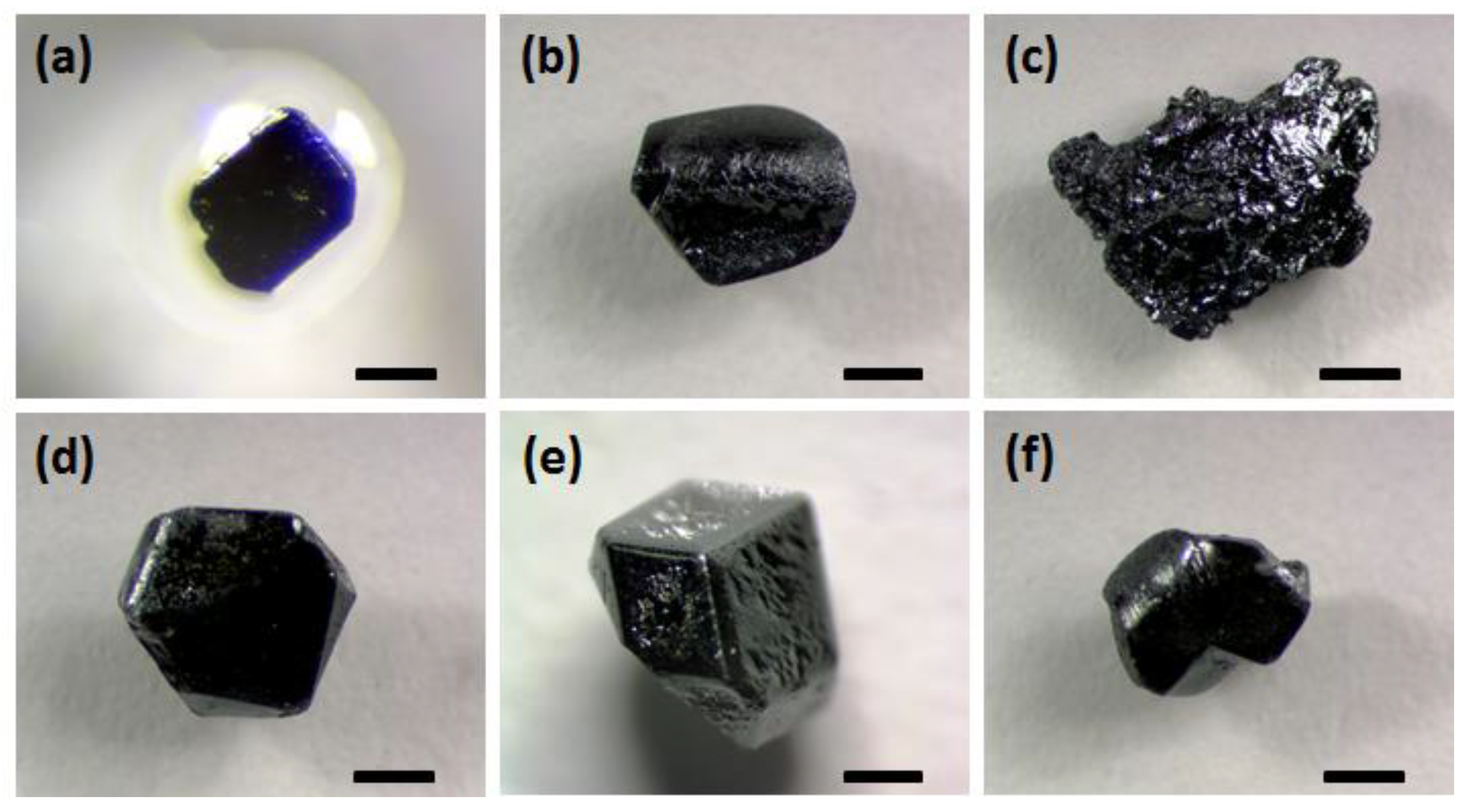

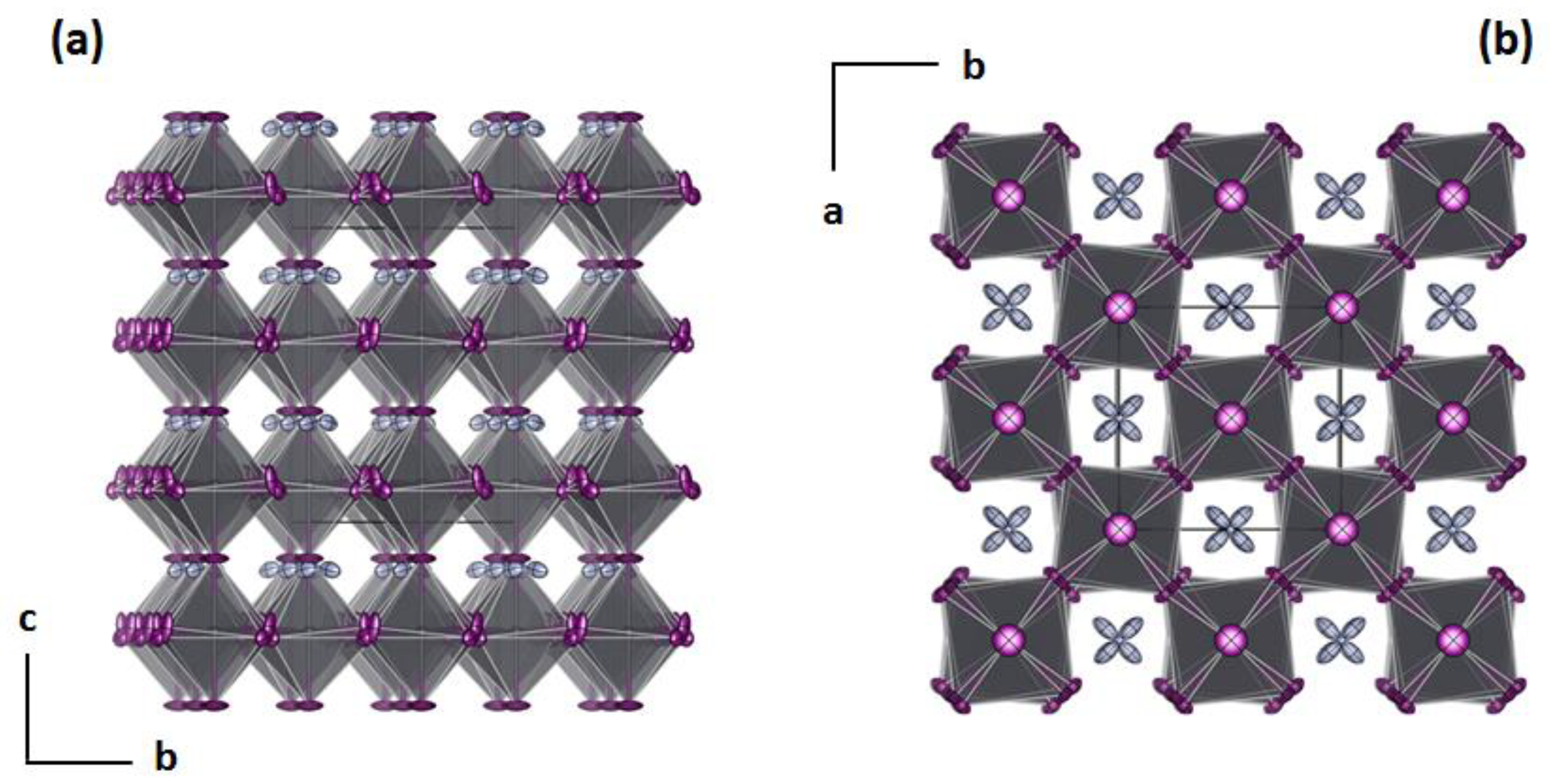
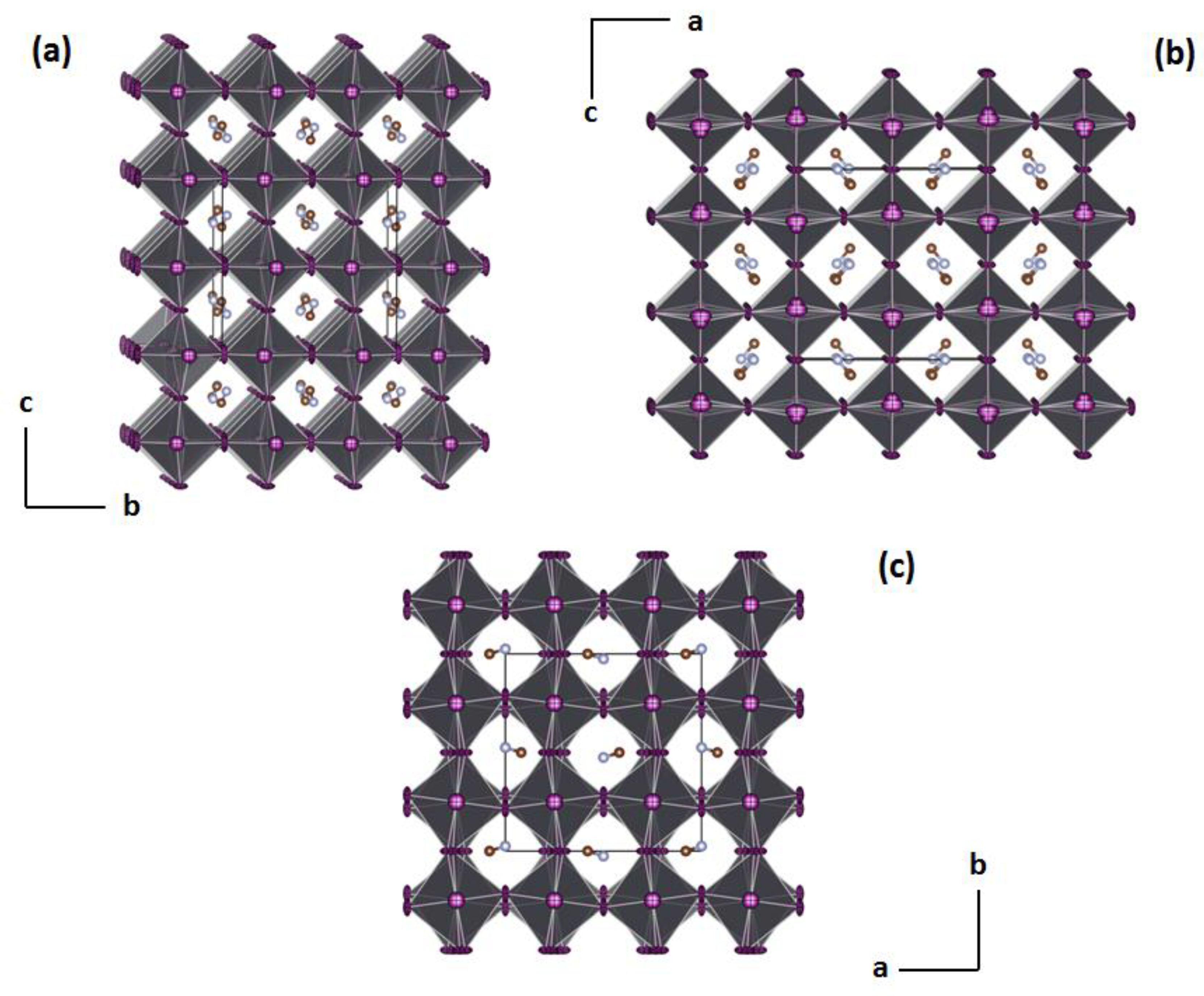
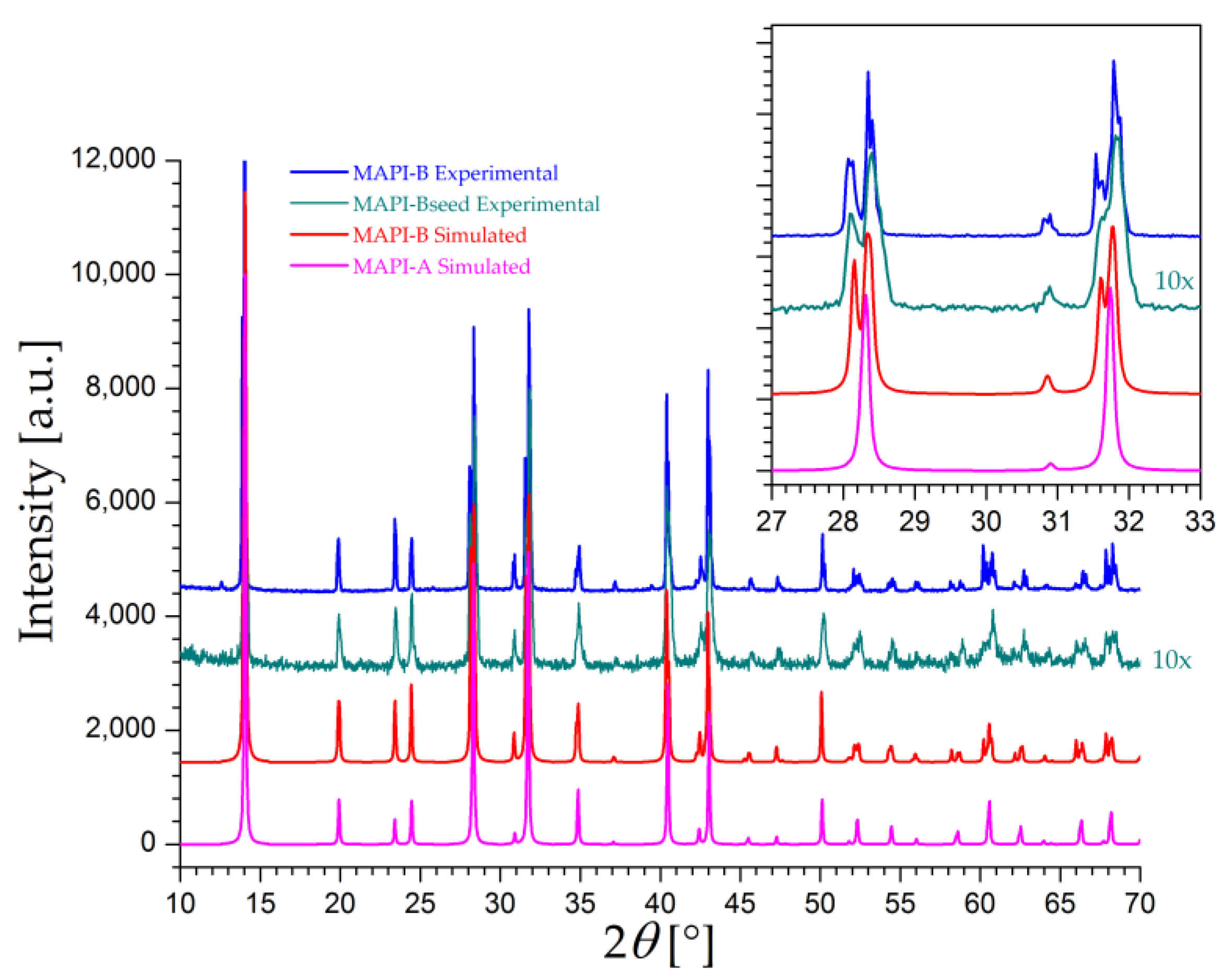

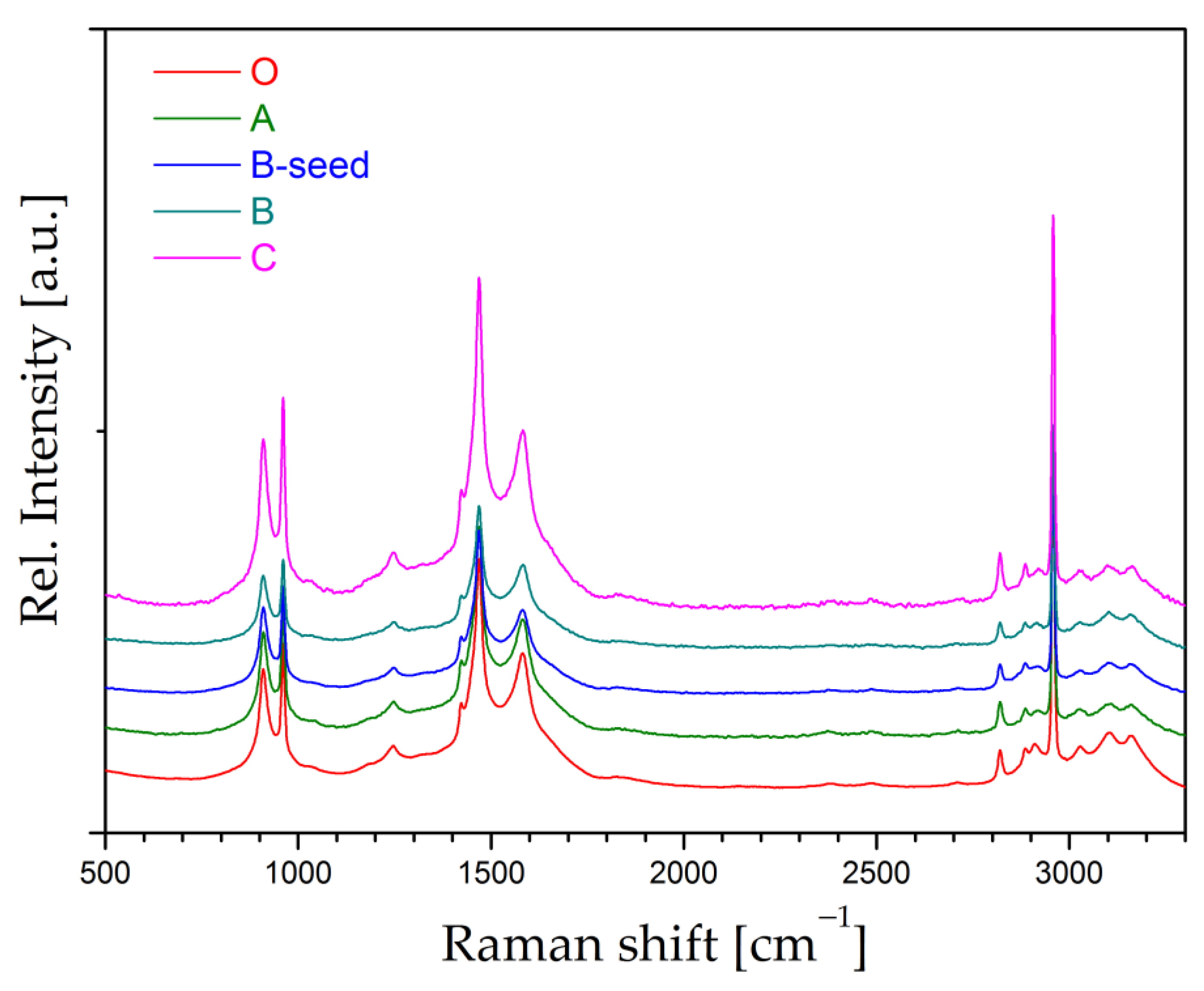
| Name | O | A | B | Bseed | C |
|---|---|---|---|---|---|
| Crystal data | |||||
| Refined formula | PbI3·24NC | PbI3·0.5[N2C2] | PbI3·NC | PbI3·0.5[N2C2] | PbI3·0.5[N2C2] |
| Temperature (K) | 296(2) | 299(2) | 298(2) | 301(2) | 296(2) |
| Crystal system | Cubic | Tetragonal | Orthorhombic | Orthorhombic | Tetragonal |
| Space group (no.) | Pm-3m (221) | I4cm (108) | Fmmm (69) | Fmmm (69) | I4cm (108) |
| a (Å) | 6.2955(6) | 8.9034(6) | 12.602(2) | 12.566(2) | 8.8972(6) |
| b (Å) | 6.2955(6) | 8.9034(6) | 12.602(2) | 12.594(4) | 8.8972(6) |
| c (Å) | 6.2955(6) | 12.6162(11) | 12.655(4) | 12.668(4) | 12.6214(9) |
| V (Å3) | 249.51(7) | 1000.09(16) | 2009.7(8) | 2004.9(10) | 999.11(15) |
| Z | 1 | 4 | 8 | 8 | 4 |
| ρcalc (g/cm3) | 4.086 | 4.077 | 4.058 | 4.068 | 4.081 |
| μ (mm−1) | 26.099 | 26.050 | 25.922 | 25.985 | 26.072 |
| Radiation | Mo Kα (λ = 0.71073) | ||||
| Crystal size (mm3) | 0.030 × 0.040 × 0.040 | 0.040 × 0.050 × 0.080 | 0.030 × 0.040 × 0.050 | 0.020 × 0.020 × 0.020 | 0.035 × 0.050 × 0.090 |
| Data collection | |||||
| 2θ range (°) | 6.472–61.482 | 6.458–71.062 | 5.592–72.680 | 5.596–77.346 | 9.150–75.226 |
| F(000) | 254 | 1016 | 1939 | 2032 | 1116 |
| (sin θ/λ)max (Å−1) | 0.719 | 0.818 | 0.834 | 0.879 | 0.859 |
| hkl ranges | −9 ≤ h ≤ 7 −8 ≤ k ≤ 9 −9 ≤ l ≤ 6 | −14 ≤ h ≤ 12 −14 ≤ k ≤ 12 −20 ≤ l ≤ 15 | −17 ≤ h ≤ 15 −20 ≤ k ≤ 20 −13 ≤ l ≤ 21 | −21 ≤ h ≤ 20 −22 ≤ k ≤ 22 −21 ≤ l ≤ 21 | −11 ≤ h ≤ 15 −15 ≤ k ≤ 15 −21 ≤ l ≤ 21 |
| Tmin − Tmax | 0.512–0.747 | 0.504–0.747 | 0.422–0.747 | 0.357–0.748 | 0.396–0.747 |
| Reflections collected/independent | 2632/111 | 5108/1114 | 4956/1188 | 7277/1550 | 9763/1330 |
| Reflections with I/2σ(I) | 110 | 895 | 489 | 995 | 878 |
| Rint | 0.0862 | 0.0356 | 0.0966 | 0.0520 | 0.0722 |
| Rσ | 0.0196 | 0.0293 | 0.0999 | 0.0467 | 0.0445 |
| Refinement | |||||
| Data/restraints/parameters | 111/0/4 | 1114/1/26 | 1188/0/21 | 1550/0/22 | 1330/1/26 |
| Final R indexes [F2 > 2σ (F2)] | R1 = 0.0483, Rw = 0.1269 | R1 = 0.0682, Rw = 0.1664 | R1 = 0.1104, Rw = 0.3340 | R1 = 0.0411, Rw = 0.0973 | R1 = 0.0734, Rw = 0.2310 |
| Final R indexes [all data] | R1 = 0.0497, Rw = 0.1274 | R1 = 0.0826, Rw = 0.1726 | R1 = 0.1983, Rw = 0.3979 | R1 = 0.0758, Rw = 0.1244 | R1 = 0.1052, Rw = 0.2585 |
| Goodness-of-fit on F2 | 1.185 | 1.203 | 1.129 | 1.058 | 1.183 |
| Extinction coefficient | // | 0.0012(2) | 0.0010(3) | 0.00112(15) | 0.0069(14) |
| Largest diff. peak/hole (e·Å−3) | +1.85/−3.28 | +3.75/−4.34 | +4.83/−8.49 | +2.10/−2.82 | +3.10/−2.67 |
| Sample | Symmetry | Pb—I Bond Length (Å) | I—Pb—I Angle (°) |
|---|---|---|---|
| Crystal O | Cubic Pm-3m | 3.1478(3) | 90.0 180.0 |
| Crystal A | Tetragonal I4cm | <3.135(15)–3.201(2)> Avg. 3.174 | <81.7(3)–98.9(2)> <171.4(3)–180.0(0)> |
| Crystal B | Orthorhombic Fmmm | <3.1573(7)–3.1763(13)> Avg. 3.166 | <86.4(2)–93.6(2)> <172.5(3)–180.0(0)> |
| Crystal Bseed | Orthorhombic Fmmm | <3.1564(15)–3.201(3)> Avg. 3.174 | <86.1(3)–93.9(3)> <173.0(3)–180.0(0)> |
| Crystal C | Tetragonal I4cm | <3.1137(13)–3.205(6)> Avg. 3.171 | <83.6(6)–97.3(6)> <168.0(0)–180.0(0)> |
| Crystal Name | Acid Name | Tb§ (°C) | Density at 25 °C (g/cm−3) | Acid Constant (pKa) * | Volume of Added Acid (μL) |
|---|---|---|---|---|---|
| O | # | # | # | # | # |
| A |  ACETIC | 118 | 1.05 | 4.74 | 30 |
| B |  FORMIC | 100.8 | 1.22 | 3.75 | 57 |
| Bseed | FORMIC | 100.8 | 1.22 | 3.75 | 19 |
| C |  TRIFLUOROACETIC | 72.4 | 1.489 | −0.25 | 40 |
Publisher’s Note: MDPI stays neutral with regard to jurisdictional claims in published maps and institutional affiliations. |
© 2022 by the authors. Licensee MDPI, Basel, Switzerland. This article is an open access article distributed under the terms and conditions of the Creative Commons Attribution (CC BY) license (https://creativecommons.org/licenses/by/4.0/).
Share and Cite
Dionigi, C.; Goudjil, M.; Ruani, G.; Bindi, L. The Effect of Short Chain Carboxylic Acids as Additives on the Crystallization of Methylammonium Lead Triiodide (MAPI). Inorganics 2022, 10, 201. https://doi.org/10.3390/inorganics10110201
Dionigi C, Goudjil M, Ruani G, Bindi L. The Effect of Short Chain Carboxylic Acids as Additives on the Crystallization of Methylammonium Lead Triiodide (MAPI). Inorganics. 2022; 10(11):201. https://doi.org/10.3390/inorganics10110201
Chicago/Turabian StyleDionigi, Chiara, Meriem Goudjil, Giampiero Ruani, and Luca Bindi. 2022. "The Effect of Short Chain Carboxylic Acids as Additives on the Crystallization of Methylammonium Lead Triiodide (MAPI)" Inorganics 10, no. 11: 201. https://doi.org/10.3390/inorganics10110201





